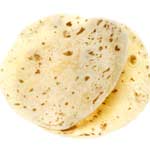|
Fixed-menu
diet.
A fixed-menu diet provides a list of all the foods you will eat. This kind
of diet can be easy to follow because the foods are selected for you. But,
you get very few different food choices which may make the diet boring and
hard to follow away from home. In addition, fixed-menu diets do not teach
the food selection skills necessary for keeping weight off. If you start
with a fixed-menu diet, you should switch eventually to a plan that helps
you learn to make meal choices on your own, such as an exchange-type diet.
Exchange-type diet
An exchange-type diet is a meal plan with a set number of servings from each
of several food groups. Within each group, foods are about equal in calories
and can be interchanged as you wish. For example, the "starch" category
could include one slice of bread or 1/2 cup of oatmeal; each is about equal
in nutritional value and calories. If your meal plan calls for two starch
choices at breakfast, you could choose to eat two slices of bread, or one
slice of bread and 1/2 cup of oatmeal. With the exchange-type diet plans,
you have more day-to-day variety and you can easily follow the diet away
from home. The most important advantage is that exchange-type diet plans
teach the food selection skills you need to keep your weight off.
Adequate Protein
The average woman 25 years of age and older should get 50 grams of protein
each day, and the average man 25 years of age and older should get 63 grams
of protein each day. Adequate protein is important because it prevents
muscle tissue from breaking down and repairs all body tissues such as skin
and teeth. To get adequate protein in your diet, make sure you eat 2-3
servings (see Figure 2) from the Meat, Poultry, Fish, Dry Beans, Eggs, and
Nuts Group on the Food Guide Pyramid every day. These foods are all good
sources of protein.
Prepackaged-meal Diet
These diets require you to buy prepackaged meals. Such meals may help you
learn appropriate portion sizes. However, they can be costly. Before
beginning this type of program, find out whether you will need to buy the
meals and how much the meals cost. You should also find out whether the
program will teach you how to select and prepare food, skills that are
needed to sustain weight loss.
Formula Diet
Formula diets are weight-loss plans that replace one or more meals with a
liquid formula. Most formula diets are balanced diets containing a mix of
protein, carbohydrate, and usually a small amount of fat. Formula diets are
usually sold as liquid or a powder to be mixed with liquid. Although formula
diets are easy to use and do promote short-term weight loss, most people
regain the weight as soon as they stop using the formula. In addition,
formula diets do not teach you how to make healthy food choices, a necessary
skill for keeping your weight off.
Questionable diets
You should avoid any diet that suggests you eat a certain nutrient, food, or
combination of foods to promote easy weight loss. Some of these diets may
work in the short term because they are low in calories. However, they are
often not well balanced and may cause nutrient deficiencies. In addition,
they do not teach eating habits that are important for long-term weight
management.
Flexible diets.
Some programs or books suggest monitoring fat only, calories only, or a
combination of the two, with the individual making the choice of both the
type and amount of food eaten. This flexible type of approach works well for
many people, and teaches them how to control what they eat. One drawback of
flexible diets is that some don't consider the total diet. For example,
programs that monitor fat only often allow people to take in unlimited
amounts of excess calories from sugars, and therefore don't lead to weight
loss.
Live With It
It is important to choose an eating plan that you can live with. The plan
should also teach you how to select and prepare healthy foods, as well as
how to maintain your new weight. Remember that many people tend to regain
lost weight. Eating a healthful and nutritious diet to maintain your new
weight, combined with regular physical activity, helps to prevent weight
regain. |


